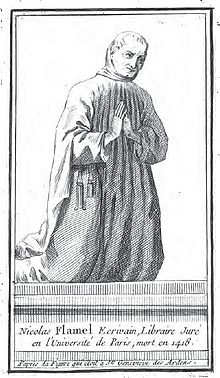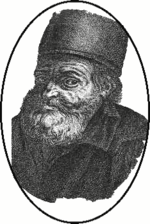Original Cover Art for Harry Potter and the Philosophers Stone
| Nicolas Flamel | |
|---|---|
 Flamel as represented in 1402 on the portal of Sainte-Geneviève des Ardens (from Étienne François Villain, 1761) | |
| Born | c. 1330 Pontoise, France |
| Died | 22 March 1418 (87–88 years) Paris, France |
| Spouse(s) | Perenelle Flamel (m. 1368) |
Nicolas Flamel (French: [nikɔla flamɛl]; c. 1330 – 22 March 1418)[1] was a French scribe and manuscript-seller. Afterwards his decease, Flamel adult a reputation equally an alchemist believed to have discovered the philosopher'southward rock and to have thereby achieved immortality. These legendary accounts first appeared in the 17th century.
Co-ordinate to texts ascribed to Flamel almost 200 years later his death, he had learned alchemical secrets from a Jewish converso on the road to Santiago de Compostela. He has since appeared as a legendary alchemist in various fictional works.
Life [edit]

Tombstone of Nicolas Flamel, 1418, Paris, Musée de Cluny
The historical Flamel lived in Paris in the 14th and 15th centuries, and his life is i of the best documented in the history of medieval abracadabra.[2] He ran ii shops as a scribe and married Perenelle in 1368. She brought the wealth of two previous husbands to the marriage. The French Cosmic couple owned several properties and contributed financially to churches, sometimes by commissioning sculptures.[3] Later in life, they were noted for their wealth and philanthropy.
Flamel lived into his 70s, and in 1410 designed his own tombstone, which was carved with the images of Christ, St. Peter, and St. Paul. The tombstone is preserved at the Musée de Cluny in Paris. Records bear witness that Flamel died in 1418.[4] He was cached in Paris at the end of the nave of the former Church of Saint-Jacques-de-la-Boucherie.[5] His volition, dated 22 Nov 1416, indicates that he was generous but that he did not have the extraordinary wealth of subsequently alchemical legend. There is no indication that the real Flamel of history was involved in alchemy, chemist's or medicine.[two]
Flamel was a real person, and he may take dabbled in alchemy, but his reputation equally an author and immortal skilful must be accepted equally an invention of the seventeenth century.[two]
House in Paris [edit]
Ane of Flamel's houses still stands in Paris, at 51 rue de Montmorency. It is the oldest stone business firm in the urban center.[6] There is an old inscription on the wall, which states, "We, plowmen and women living at the porch of this house, congenital in 1407, are requested to say every twenty-four hour period an 'Our Father' and an 'Ave Maria' praying God that His grace forgive poor and dead sinners." As of 2008, the ground floor housed a restaurant.[7] A Paris street near the Louvre Museum, the rue Nicolas Flamel, has been named afterward him; information technology intersects with the rue Pernelle, named afterward his wife.[seven]
-

Flamel's Paris domicile, now a restaurant
-

A closer shot of the Auberge Nicolas Flamel, June 2008
-

Rue Nicolas Flamel street sign in Paris
-

Plaque on abode
Posthumous reputation as an alchemist [edit]

This imaginative portrait of Nicolas Flamel dates from the 19th century.
Legendary accounts of Flamel's life are based on 17th-century works, primarily Livre des figures hiéroglyphiques. The essence of his reputation are claims that he succeeded at the two goals of alchemy: that he made the philosopher's rock, which turns base metals into gold, and that he and his wife, Perenelle, achieved immortality through the "Elixir of Life".
An alchemical volume, published in Paris in 1612 as Livre des figures hiéroglyphiques and in London in 1624 as Exposition of the Hieroglyphical Figures was attributed to Flamel.[eight] It is a collection of designs purportedly deputed by Flamel for a tympanum at the Cimetière des Innocents in Paris, long disappeared at the time the work was published. In the publisher'south introduction, Flamel's search for the philosopher's stone was described. Co-ordinate to that introduction, Flamel had made it his life's piece of work to understand the text of a mysterious 21-page book he had purchased. The introduction claims that, effectually 1378, he traveled to Spain for assist with translation. On the mode back, he reported that he met a sage, who identified Flamel's book as being a copy of the original Book of Abramelin the Mage. With this knowledge, over the next few years, Flamel and his wife allegedly decoded plenty of the book to successfully replicate its recipe for the philosopher'south stone, producing outset silverish in 1382 and so gold. Also, Flamel is said to accept studied some texts in Hebrew.
The validity of this story was starting time questioned in 1761 by Etienne Villain. He claimed that the source of the Flamel legend was P. Arnauld de la Chevalerie, publisher of Exposition of the Hieroglyphical Figures, who wrote the book under the pseudonym Eiranaeus Orandus.[ix] Other writers have defended the legendary account of Flamel's life, which has been embellished by stories of sightings in the 17th and 18th centuries and expanded in fictitious works ever since.
Flamel had achieved legendary status inside the circles of alchemy by the mid 17th century, with references in Isaac Newton's journals to "the Caduceus, the Dragons of Flammel".[10] Interest in Flamel revived in the 19th century: Victor Hugo mentioned him in The Hunchback of Notre Dame, Erik Satie was intrigued by Flamel,[11] and Albert Pike refers to Nicholas Flamel in his volume Morals and Dogma of the Scottish Rite of Freemasonry. Flamel's reputation as an alchemist was further bolstered in the late 20th century past his depiction equally the creator of the eponymous alchemical substance in the acknowledged novel Harry Potter and the Philosopher's Stone [12] and its film adaptation. He likewise appears in the 2018 spinoff picture show Fantastic Beasts: The Crimes of Grindelwald, where he is portrayed by Brontis Jodorowsky.
Works ascribed to Flamel [edit]

Starting time-edition embrace of the volume of the hieroglyphic figures, not published until 1612
- Le Livre des figures hiéroglyphiques (The Book of hieroglyphic figures), first published in Trois traictez de la philosophie naturelle, Paris, Veuve Guillemot, 1612
- Le sommaire philosophique (The Philosophical summary), beginning published in De la transformation métallique, Paris, Guillaume Guillard, 1561
- Le Livre des laveures (The Book of washing), manuscript BnF MS. Français 19978
- Le Bréviaire de Flamel (Flamel's breviary), manuscript BnF MS. Français 14765
In popular civilisation [edit]
Flamel has been portrayed in popular fiction as a legendary figure who holds the fundamental to immortality or the philosopher'south stone. For example, in Victor Hugo's 1831 novel Notre Dame de Paris, the tragic main grapheme Claude Frollo is a young priest and alchemist who spends much of his time studying the carvings in Les Innocents, trying to fathom Flamel's secrets. Into the twentieth and twenty-outset centuries, works such as Harry Potter (1997 to the 2018 moving-picture show), Fullmetal Alchemist (2001–2010), The Secrets of the Immortal Nicholas Flamel (2007–2012), and As Above, And then Beneath (2014) accept propagated the legend of Nicolas Flamel.
The works of Nicolas Flamel are central to several missions constitute in the video game Assassins Creed: Unity.
Notes [edit]
- ^ Co-ordinate to Nigel Wilkins: Nicolas Flamel, des livres et de 50'or, Chapter 1: De Paris.
- ^ a b c Dixon 1994, p. xvii.
- ^ Dixon 1994, p. sixteen.
- ^ Cohen, Kathleen (1973). Metamorphosis of a expiry symbol: the transi tomb in the late Middle Ages and the Renaissance. University of California Printing. p. 98.
- ^ Hauck, Dennis William (2008). The Complete Idiot's Guide to Abracadabra. Penguin.
- ^ , McAuliffe, Mary. Paris Discovered: Explorations in the City of Calorie-free. Princeton Book Company, 2006. ISBN 978-0-87127-287-4
- ^ a b Brooke, Anna Due east. (2008). Frommer's Paris and Disneyland Resort Paris With Your Family: From Captivating Culture to the Magic of Disneyland . New York: John Wiley & Sons. p. 134. ISBN9780470714577.
- ^ Laurinda Dixon, ed., Nicolas Flamel, his Exposition of the Hieroglyphical Figures (1624) (New York: Garland) 1994.
- ^ Dixon 1994, p. fourteen.
- ^ Newton, Isaac. "Sententiæ luciferæ et Conclusiones notabiles". Keynes MS 56 (quoted in Westfall, Never at Rest, p. 299) . Retrieved May 15, 2011.
- ^ Wilkins 1993.
- ^ "Who is Nicholas Flamel? And other historical figures". nlm.nih.gov. United States National Library of Medicine. 24 August 2007. Retrieved 22 Nov 2014.
References [edit]
- Decoding the By: The Real Magician's Stone, November xv, 2006, History Channel video documentary
- The Philosopher's Stone: A Quest for the Secrets of Alchemy, 2001, Peter Marshall, ISBN 0-330-48910-0
- Creations of Fire, Cathy Cobb & Harold Goldwhite, 2002, ISBN 0-7382-0594-X
- Wilkins, Nigel, Nicolas Flamel- des livres et de l'or, Éditions Imago, 1993, ISBN 2-902702-77-9
- Dixon, Laurinda (1994). Nicolas Flamel. His Exposition of the Hieroglyphicall Figures (1624). Garland Publishing.
- Secrets of the Immortal Nicholas Flamel. The Alchemyst, The Magician, The Sorceress, The Necromancer, The Warlock, and The Enchantress
External links [edit]
- The Abracadabra Web Site, alchemical writings ascribed to Flamel.
Source: https://en.wikipedia.org/wiki/Nicolas_Flamel
0 Response to "Original Cover Art for Harry Potter and the Philosophers Stone"
Postar um comentário